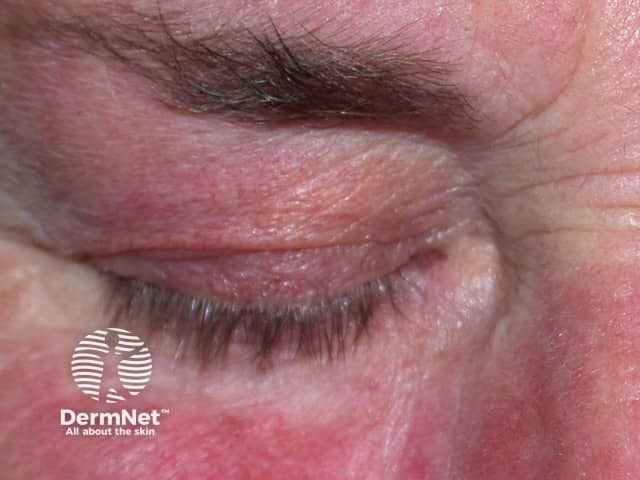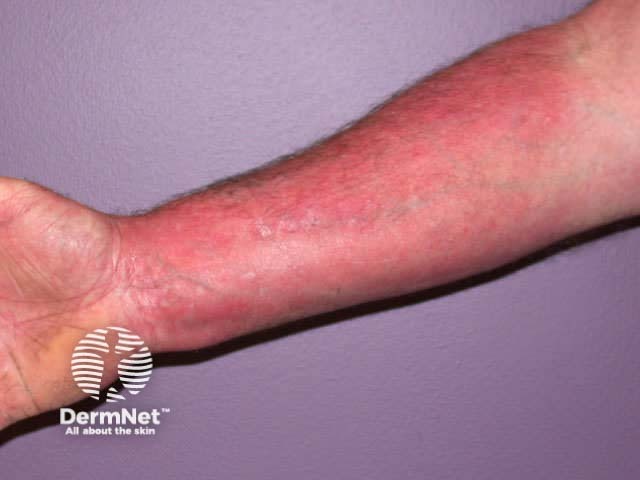Main menu
Common skin conditions

NEWS
Join DermNet PRO
Read more
Quick links
Topical corticosteroid withdrawal — extra information
Topical corticosteroid withdrawal
Last Reviewed: July, 2023
Author(s): Dr Hyun Kyoung Lee, Medical Registrar; and Dr Louise Reiche, Dermatologist, Palmerston North, New Zealand (2023); Minor update Jan 2025.
Reviewing dermatologist: Dr Ian Coulson
Edited by the DermNet content department
Introduction
Demographics
Causes
Clinical features
Variation in skin types
Complications
Diagnosis
Differential diagnoses
Treatment
Prevention
Outcome
What is topical corticosteroid withdrawal?
Topical corticosteroid withdrawal is a rare rebound reaction in patients with topical steroid overuse that occurs after discontinuation.
This is usually caused by prolonged use of moderate to high strength topical corticosteroids. Withdrawal may present with skin burning, itching, redness, scaling, swelling, papules, or pustules.

Redness and swelling of the lids - steroid withdrawal after prolonged potent steroid use on the face.

Redness and swelling of the forearm after abrupt discontinuation of prolonged potent topical steroid use. Palms are not affected (red sleeve sign).
Who gets topical corticosteroid withdrawal?
The prevalence of topical corticosteroid withdrawal reactions is unknown.
Major risk factors for topical steroid withdrawal include:
- Topical corticosteroid use on the face (97%)
- History of atopy (76%)
- Oral corticosteroid use (42%)
- Female gender (79%)
- Adults over the age of 18 (83%)
- Topical corticosteroid of medium (69%) or high (21%) potency
- Topical corticosteroid treatment duration of 6 months or more (63%).
What causes topical corticosteroid withdrawal?
The following mechanisms may explain the pathogenesis of topical steroid withdrawal:
- Tachyphylaxis (reduced response) with continued application, leading to usage of higher doses
- Upregulation of glucocorticoid receptor b in atopic dermatitis patients with poor response to topical steroids
- Keratinocytes have continued suppression of self-cortisol production after topical steroid cessation
- Topical corticosteroids cause vasoconstriction, but on withdrawal rebound vasodilation occurs from increased nitric oxide release, leading to skin erythema
- Barrier disruption induces a rebound cytokine cascade once the anti-inflammatory effects from topical corticosteroids are withdrawn
- Elevated NAD+oxidation of mitochondrial complex 1 and conversion of tryptophan into kynurenine metabolites and nicotinic acid.
What are the clinical features of topical corticosteroid withdrawal?
Prior to stopping the steroid, the skin often appears normal or near-normal, although patients with atopic dermatitis may have itching or prurigo-like nodules. The onset of withdrawal from the time of discontinuation ranges from 48 hours to over 3 months.
Withdrawal typically occurs in four stages.
- A few days (usually) after discontinuation, there is an acute eruption of burning red, exudative skin which may extend to untreated areas.
- Skin becomes dry and itchy with shedding (desquamation).
- Skin starts to recover but has increased sensitivity and intermittent flares may occur.
- Skin recovers to the state prior to topical corticosteroid cessation. The recovery process may take weeks to years.
Symptoms:
Cutaneous features:
- Diffusely red skin
- ‘Elephant wrinkles’: thickened skin with reduced elasticity, usually affecting extensor surfaces
- Red sleeve sign: erythema of limbs, sparing the palms and soles
- Headlight sign: erythema of the face, sparing the nose and perioral skin
- Shedding skin (desquamation)
- Swelling (oedema)
- Serous ooze (exudate)
- Papules +/- nodules
- Pustules
- Telangiectasia.
Subtypes of topical steroid withdrawal
- Erythematoedematous subtype: commonly seen in patients with chronic atopic dermatitis, characterised by burning sensation, erythema, oedema, and scaling.
- Papulopustular subtype: commonly seen after steroid use for pigmentation changes or other cosmetic reasons, characterised by papules, pustules, and erythema. This subtype is less commonly affected by burning, stinging, or swelling.
How do clinical features vary in differing types of skin?
Darker or grey skin changes, rather than redness, may feature in more pigmented skin types.
What are the complications of topical corticosteroid withdrawal?
- Intense itching and sleep disturbance.
- Flare of pre-treatment skin disorder, particularly atopic dermatitis.
- Secondary cutaneous infection.
- Depression/anxiety (26%).
- Suicidal ideation (16%) from prolonged debilitation.
- Use of non-conventional therapies.
- Steroid phobia for future treatments.
How is topical corticosteroid withdrawal diagnosed?
There is a lack of consensus on diagnostic criteria for topical corticosteroid withdrawal however, in recent literature, the key features are:
- Frequent and prolonged topical steroid use on the area of initial eruption
- Frequent and prolonged topical steroid use on the facial or genital region
- Burning or itch
- Confluent redness (erythema) within days to weeks of topical steroid cessation
- Frequently associated with:
- History of atopy, especially atopic dermatitis
- History of oral prednisone use for skin symptoms
- Skin sensitivity
- Excessive skin exfoliation (shedding)
- Oozing skin
- Swelling (oedema), especially of the eyelids or ankles
- ‘Elephant wrinkles’ of the posterior elbows and anterior knees (extensors)
- Red sleeve sign.
One of the challenges is determining whether the skin reaction observed is due to the stopping of topical corticosteroids, or a worsening of the underlying skin disease for which the steroids were prescribed.
Patch testing can be useful in excluding contact dermatitis to the topical corticosteroid or cream excipients, or other topical agents (eg, emollients), although this may be difficult if there are insufficient areas of normal skin.
Histology is not useful in the diagnosis of topical corticosteroid withdrawal due to its non-specific histological features of epidermal atrophy, spongiosis, and parakeratosis.
What is the differential diagnosis for topical corticosteroid withdrawal?
What is the treatment for topical corticosteroid withdrawal?
Many different treatments are available, however they are not associated with a reduced time to resolution.
General measures
- Emollients and moisturisers.
- Cold compresses, ice, and gabapentin for burning pain.
- Antihistamines for itch.
- Simple analgesia.
- Psychological support.
Specific measures
- Discontinuation of topical corticosteroids is the mainstay of treatment but it is important to monitor for rebound reactions.
- Abrupt cessation vs tapering is debated.
- Tapering dose of oral corticosteroids.
- Dupilumab may be considered in atopic dermatitis patients.
- Calcineurin inhibitors and tetracycline antibiotics for the papulopustular subtype.
- Prevention and treatment of any secondary infection.
- Phototherapy.
- Immunosuppressants.
How do you prevent topical corticosteroid withdrawal?
- Reduce the frequency and potency of topical corticosteroid use as soon as inflammatory skin disorders clear (avoid ongoing daily use ‘to prevent recurrence’).
- Avoid continued use of moderate to potent topical corticosteroids on the face.
- Minimise continuous prolonged corticosteroid treatment duration eg, over 2 weeks. Some conditions such as vulval lichen sclerosus may need more than 4 weeks therapy to maximise beneficial response.
- Reduce topical steroid potency and application from daily to twice weekly after 2–4 weeks of use.
Concerns about the risk of topical corticosteroid withdrawal should not prevent adequate treatment of atopic dermatitis and other skin conditions, as far more people respond to appropriate topical steroid use than develop withdrawal.
What is the outcome for topical corticosteroid withdrawal?
There are currently no specific treatments that clearly reduce the time to resolution, which can range from 72 hours to months, with the majority (77%) recovering after 3 months.
Topical corticosteroid withdrawal can have a prolonged course of up to 5 years after cessation in a small minority of patients.
Bibliography
- Brookes TS, Barlow R, Mohandas P, Bewley A. Topical Steroid Withdrawal: An Emerging Clinical Problem. Clin Exp Dermatol. 2023;llad161. doi: 10.1093/ced/llad161. Journal
- Fukaya M, Sato K, Sato M, et al. Topical steroid addiction in atopic dermatitis. Drug Healthc Patient Saf. 2014;6:131–8. doi: 10.2147/dhps.s6920. Journal
- Hajar T, Leshem YA, Hanifin JM, et al. A systematic review of topical corticosteroid withdrawal (“steroid addiction”) in patients with atopic dermatitis and other dermatoses. J Am Acad Dermatol. 2015;72(3):541–549.e2. doi: 10.1016/j.jaad.2014.11.024. Journal
- Hwang J, Lio PA. Topical corticosteroid withdrawal (‘steroid addiction’): an update of a systematic review. J Dermatolog Treat. 2022;33(3):1293–8. doi: 10.1080/09546634.2021.1882659. Journal
- Sheary B. Steroid Withdrawal Effects Following Long-term Topical Corticosteroid Use. Dermatitis. 2018;29(4):213–8. doi: 10.1097/DER.0000000000000387. Journal
- Shobnam N, Ratley G, Saksena S et al. - Topical steroid withdrawal is a targetable overproduction of nicotinic acid from mitochondrial complex I overexpression, British Journal of Dermatology, Volume 191, Issue Supplement 2, August 2024. Journal
- Sheary B. Topical corticosteroid addiction and withdrawal – An overview for GPs. Aust Fam Physician. 2016;45(6):386–8. Journal
- Tan SY, Chandran NS, Choi ECE. Steroid Phobia: Is There a Basis? A Review of Topical Steroid Safety, Addiction and Withdrawal. Clin Drug Investig. 2021;41(10):835–42. doi: 10.1007/s40261-021-01072-z. Journal
On DermNet
Other websites
- How do I apply topical corticosteroids for the treatment of eczema? (PDF) — The Australasian College of Dermatologists
- Consensus statement: Topical corticosteroids in paediatric eczema (PDF) — The Australasian College of Dermatologists
